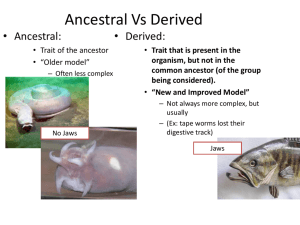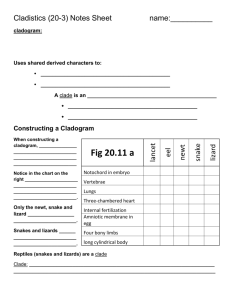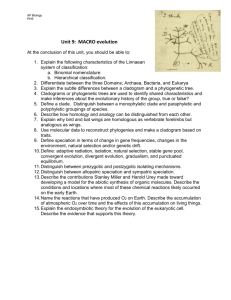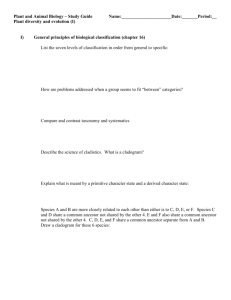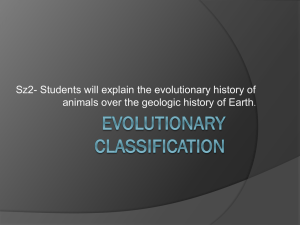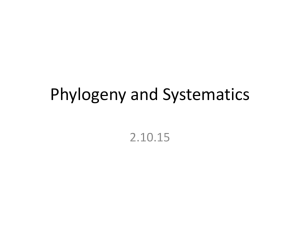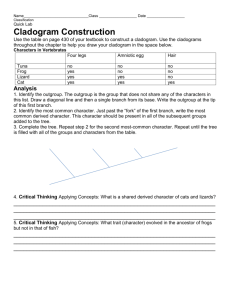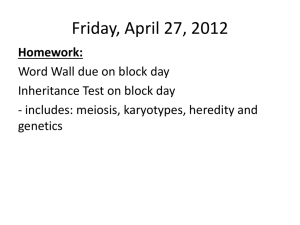Presentation
advertisement
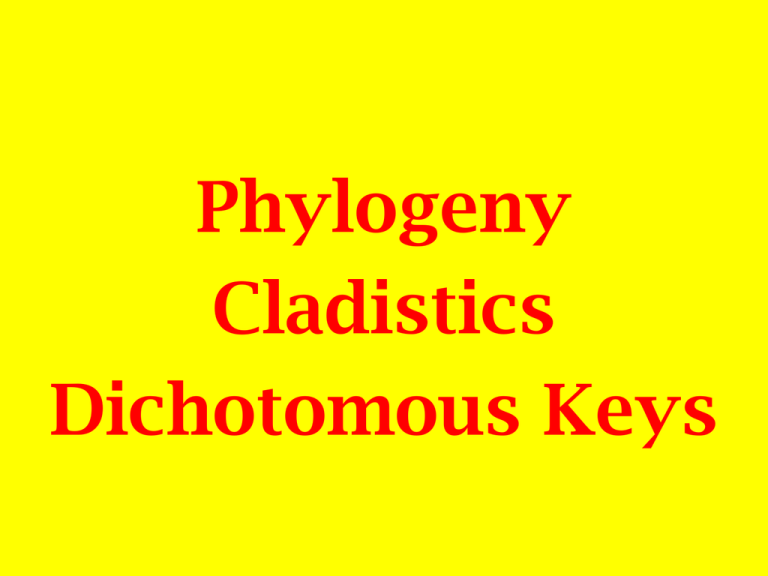
Phylogeny Cladistics Dichotomous Keys Important Terms • • • • • • Phylogeny Phylogenetic Tree Cladogram Clade Ancestral trait Derived trait Phylogenetic Tree • Phylogenyevolutionary development and history of a species or higher taxonomic grouping of organisms • Phylogenetic Treeshows evolutionary relationships • More historical than cladogram 3 Cladogram • Shows evolutionary relationship of a group of organisms • Each clade (group) share something in common • Clade is a taxonomic group that includes only a single ancestor and all of its decendants • Ancestral traits are the oldest • Derived traits evolved later • A derived trait is a trait that is present in an organism, but was absent in the last common ancestor of the group being considered 5 Cladogram for Transportation Wheels are the most ancestral – What does ancestral mean? Wings are the most derived – What does it mean to be derived? 6 Constructing Cladograms https://www.youtube.com/watch?v=46L_2R I1k3k https://www.youtube.com/watch?v=_C6cqs Of2mI Construct a Cladogram 8 Gorilla • Four limbs • Fur • Lost tail 9 Tiger • Four limbs • Fur • Tail 10 Lizard • Four limbs • Tail 11 Fish • Tail 12 Chimpanzee • Four limbs • Fur • Lost tail 13 Clade With Fur 14 Clade With 4 Limbs 15 Clade With No Tail 16 Characteristics for Constructing Cladogram • • • • Tail is the most ancestral trait Four limbs is the oldest derived trait Fur is a later derived trait Loss of tail is the most recent derived trait 17 Gorilla Chimpanzee Tiger Lizard Fish Tail Lost Fur Four Limbs 18 Questions based on cladogram • 1. Which organisms have lost a tail? • 2. Which organisms have fur? • 3. What is the oldest ancestor? • 4. What is the most recent ancestor? 1. Which organisms have claws? 2. What does a perch have that a hagfish does not have? 3. What characteristic does a pigeon have that no other organism has? 4. What does a salamander have that a perch and hagfish do not share? Dichotomous Keys • A written dichotomous key presents the reader with two statements that describe certain characteristics. • The statements should be mutually exclusive for the key to work efficiently. --For example, 'it is either red or it isn't'. • On selecting one, the reader is presented with the next couplet choice in the key and so on - to eventually arrive at an identification. HOW IT WORKS: • • • • • • Go to start Select a next level choice Select a next level choice Continue Arrive at the lowest possible level Organism is identified as much as possible If the description at each level does not appear accurate: 1. Back up to some earlier couplet and start over 2. Question each decision more carefully. 3. A verification step is important by comparing the specimen with any further details available including a description, photographs and other reference. Limitations of dichotomous keys: • If the organism is not included in the key - it would never be found and this volume remains a work in progress • dilemmas due to individual variations, so with any dichotomous key it helps to have two or three examples to improve sorting • tend to become increasingly cumbersome as the lower levels are reached especially at genus level and below
